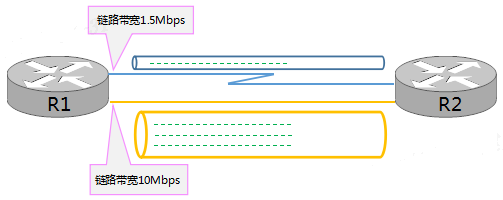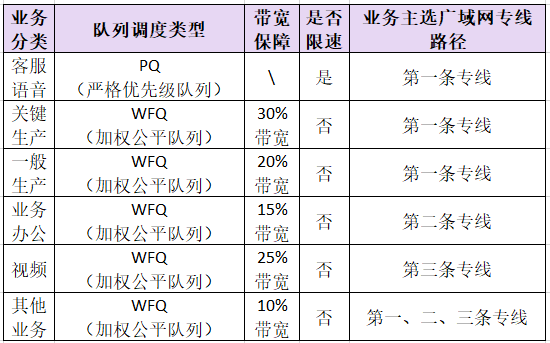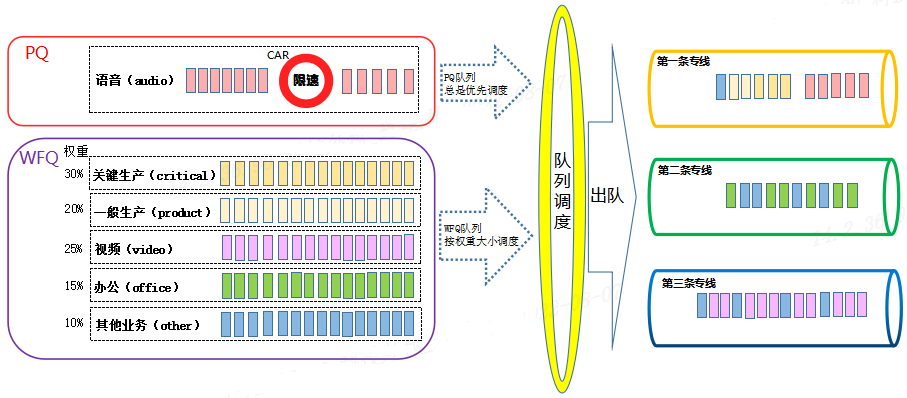The network is so network quality of service QoS technology

The network is so network quality of service QoS technology
1. Introduction
The branches of the national financial industry are connected to the headquarters data center through leased WAN dedicated lines, carrying a wide variety of services such as online transaction production systems, intelligent tellers, customer service voice, collaborative office, instant messaging, and file transfer. Performance requirements vary. The default network forwarding rules are first-in, first-out and best-effort. If all services are treated equally without distinction, it is easy to cause network congestion during peak business hours, and important production services cannot be guaranteed end-to-end network performance. adversely affect the user experience. Therefore, it is very necessary to deploy the QoS technology of differentiated services in the WAN.
QoS is the abbreviation of Quality of Service. Its purpose is to provide end-to-end service quality assurance for various business needs.
2. Basic Concepts of QoS
QoS uses the following parameters (network characteristics) as a measure to provide service quality assurance for key services and enable them to obtain predictable service levels.
- Bandwidth (throughput)
- delay
- Jitter (Latency Variation)
- Packet loss rate
2.1 Bandwidth
Bandwidth, also known as throughput, refers to the maximum number of bits of data transmitted from one end of the network to the other in a unit of time (1s). It can also be understood as the specific data between two nodes of the network. The average rate of the flow. The unit of bandwidth is bits per second (bit/s, abbreviated as bps).
Bandwidth can be used as a metaphor for the urban water supply network to help understand its meaning: the diameter of the water supply pipeline is like bandwidth, and water is like the data transmitted by the network. The larger the diameter of the pipeline, the greater the water supply and drainage capacity. That is, the greater the bandwidth, the greater the ability to transmit data.

figure 1
With the rapid development of the financial industry, business traffic has also surged, and the requirements for network transmission capacity have become higher and higher. The best way to adapt to business development is of course to increase the bandwidth of the network line. However, due to the high cost of cross-regional long-distance WAN bandwidth, considering the cost of operation and maintenance, it is impossible to expand the network bandwidth indefinitely. Therefore, network maintenance personnel are required to make full use of limited WAN bandwidth line resources to ensure that all business traffic can be forwarded normally and efficiently on the network.
2.2 Delay
Latency, also called delay, refers to the time it takes for a packet or packet to be sent from one end of the network to the other. Taking voice transmission as an example, the delay refers to the time from when the speaker starts to speak until the other party hears the content. If the delay is too large, it will cause the sound to be choppy or broken.
Usually, each node on the route network will cause delay, and some points cause very little delay, so we can ignore it in the actual environment; some delays are relatively large and need to be paid attention to. The delays in the network mainly fall into the following categories:
Forwarding/Processing Latency: Refers to the processing time between when a router (or switch) fully receives a packet and when it is placed in the output queue. The internal processing power of different device models varies, but the forwarding/processing delay is usually a negligible fraction of the overall delay budget calculation.
Queue delay: The queue delay refers to the time that the data packet waits for the device to send other data packets in the queue first. Taking the nucleic acid test as an example, in fact, the nucleic acid throat swab test time is short, but if there are too many people to be tested, there will be a queue. Therefore, the queue delay can be understood as when the nucleic acid test is performed, due to the large number of people. If the waiting time in the queue is long, the time from the start of the queue to the start of nucleic acid production can be understood as the queue delay. From a router perspective, usually queue delays are just the router's output queues, since input queues in routers are usually negligible. However, the queuing time can also reach hundreds of milliseconds or more.
Serialization Latency: Refers to the time it takes for the device's physical interface to encode the bits in the packet. If the link speed is fast, encoding the bits onto the link will be faster; if the link speed is slow, it will take more time to encode the bits onto the link. Likewise, it takes less time to encode bits in smaller packets onto the link than larger packets. The serialization delay of a packet can be calculated using the following formula: transmitted bits/link speed.
Transmission Latency: The time it takes for a packet to travel from one end of the cable to the other. Electrical and optical interfaces travel at close to the speed of light, and the only factor that affects transmission delay is link length. Therefore, in practice, the transmission delay of common LAN links can be ignored, and the transmission delay of WAN reaching hundreds of kilometers or even thousands of kilometers has become a non-negligible part of the overall delay.

figure 2
2.3 Jitter
Jitter, that is, delay variation, refers to the different delays experienced by different packets in the same service flow. In packet networks, the composition of delay is varied, so jitter is always present, but the question is whether the jitter is severe enough to degrade the quality of service of an application.
Typically, data applications will experience some jitter, but no degradation in service quality. However, some service types, especially real-time services such as audio and video, have very low tolerance to jitter, and the difference in packet arrival time will cause discontinuities in the voice.
2.4 Packet Loss Rate
Packet loss (Loss) refers to the loss of data packets. There are many factors that cause packet loss, such as equipment hardware failure, line failure, network congestion, frame check sequence (FCS) failure, and so on.
A small amount of packet loss has little impact on the service. For example, in voice transmission, if a bit or packet of information is lost, both parties in the call may not notice it, or it will not affect the understanding of the meaning. Using the Transmission Control Protocol (TCP) to transmit data can also handle a small amount of packet loss because TCP allows lost information to be retransmitted. But a lot of packet loss will affect the transmission efficiency. Therefore, QoS needs to pay attention to the statistical data of packet loss - the packet loss rate.
The packet loss rate refers to the percentage of lost packets in the transmitted packets during network transmission.
3. QoS application deployment
Since different end-user (service) traffic has different requirements for network performance, and the financial industry has its own level of attention to different services, the following QoS deployment can be performed on the WAN with reference to the above two aspects:
First, all business traffic is classified into customer service voice (audio), critical production (critical), general production (product), video (video), office (office), and other services (other).
Then perform corresponding QoS processing on each type of business traffic.
3.1 Customer Service Voice Service
Because the voice service has a very low tolerance for delay and jitter, that is, a consistent low delay is required; at the same time, voice customer service also belongs to the highest level in the sequence of importance levels of financial services. Therefore, the queue scheduling priority of the customer service voice service traffic (audio) is set to the highest priority. This ensures that customer service voice traffic is always forwarded first, the impact on bandwidth is minimized, and the delay and jitter are always kept to a minimum level within a controllable range.
Although the customer service voice service is very important, its queue scheduling priority is set to the highest priority. If the service traffic is very large and occupies all bandwidth resources under special circumstances, other services will be collectively interrupted due to the lack of bandwidth resources. Obviously, This is also unreasonable. Therefore, it is also necessary to limit the speed of the customer service voice service traffic.
Therefore, the following QoS processing can be performed for the customer service voice service: PQ (Priority Queue, priority queue) is used for queue scheduling, and the maximum bandwidth rate is limited according to the normal required rate.
3.2 Key production and general production operations
Online transaction production is a key production business and has high requirements on bandwidth and packet loss rate. Therefore, key production service traffic (critical) is guaranteed by key QoS bandwidth to ensure that the critical production service traffic can always enjoy sufficient bandwidth for forwarding, so as not to cause a large number of packet loss due to network congestion. In actual deployment, we can also subdivide key production businesses into specific types of important businesses.
The general production business is only less important than the critical production business, so a certain QoS bandwidth guarantee is also required, and the guaranteed bandwidth ratio is slightly lower than that of the critical production.
3.3 Video Services
Video services mainly refer to video conferencing services. Video conferencing requires consistent low latency and high throughput. Therefore, certain QoS bandwidth guarantees are also required for video traffic (video). The main line of the private line is set to the third line (the backup line for the main production line and the main office line), which is separated from the production and office business traffic, and can make full use of the bandwidth resources of multiple WAN private lines.
3.4 Office business
There are many types of office services, and a certain QoS bandwidth guarantee is generally allocated. At the same time, with the help of the routing strategy, the main line of the WAN dedicated line for office business traffic (office) is set as the second line (the backup line for the production main line and the video main line). It is separated from production and video service traffic, and can make full use of the bandwidth resources of multiple WAN dedicated lines.
3.5 Other business
Other business refers to the remaining business traffic (other) that is not clearly classified. The business importance level is relatively low. In order to ensure that all types of business traffic have the opportunity to be forwarded, a relatively low proportion is still given to other business traffic (other). QoS bandwidth guarantee.
3.6 Summary of QoS Deployment
In summary, we can deploy the following QoS applications for financial services.

Table 1

image 3
4. Summary
With the development of services, QoS policies also need to be dynamically optimized. The traditional network is implemented based on distributed protocols, and the configuration process adopts the form of hop-by-hop configuration, which inevitably leads to complex QoS policy deployment and optimization and adjustment operations, and is prone to errors. The WAN based on SDN technology can make QoS policy deployment more flexible and agile with the help of the characteristics of SDN automatic network configuration; it can collect more accurate global network traffic status information, such as transmission delay, bandwidth, packet loss rate, and make QoS network traffic scheduling more accurate. Accurate; it can centrally manage and control all network devices and network traffic from a global network view to ensure the consistency of QoS policies across the network. In short, in the WAN of the financial industry, by configuring QoS policies, network traffic can be controlled, avoiding and managing network congestion, reducing packet loss rate, and providing differentiated services for different services (voice, video, data, etc.), ensuring important The production business is running stably.
Networks are not born this way. With the development of technologies and changes in application scenarios, the network architecture is also evolving iteratively, eventually forming the foundation of a reliable and stable network infrastructure for the digital economy. In this, we analyze various network scenarios to show you how the network is.